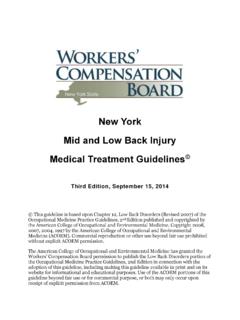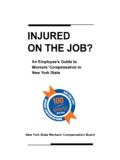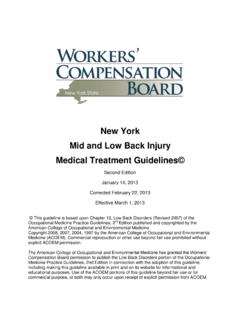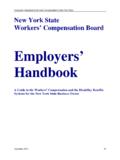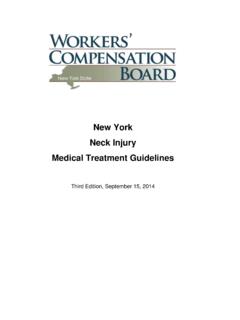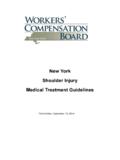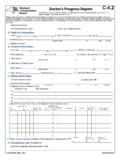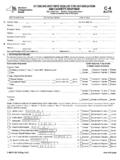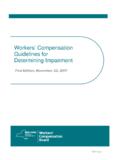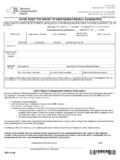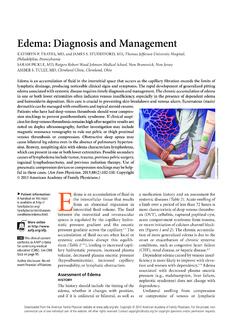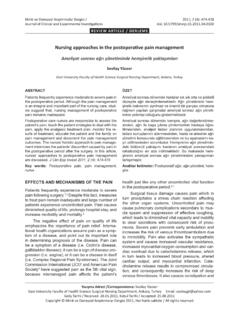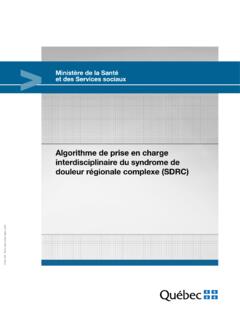Transcription of Complex Regional Pain Syndrome - wcb.ny.gov
1 Complex Regional pain Syndrome Effective: May 02, 2022 Adapted by NYS Workers Compensation Board ( WCB ) from MDGuidelines with permission of Reed Group, Ltd. ( ReedGroup ), which is not responsible for WCB s modifications. MDGuidelines are Copyright 2019 Reed Group, Ltd. All Rights Reserved. No part of this publication may be reproduced, displayed, disseminated, modified, or incorporated in any form without prior written permission from ReedGroup and WCB. Notwithstanding the foregoing, this publication may be viewed and printed solely for internal use as a reference, including to assist in compliance with WCL Sec. 13-0 and 12 NYCRR Part 44[0], provided that (i) users shall not sell or distribute, display, or otherwise provide such copies to others or otherwise commercially exploit the material. Commercial licenses, which provide access to the online text-searchable version of MDGuidelines , are available from ReedGroup at NYS WCB MTG Complex Regional pain Syndrome 2 The NYS Workers Compensation Board would like to thank the members of the New York Workers Compensation Board Medical Advisory Committee (MAC).
2 The MAC served as the Board s advisory body to adapt the American College of Occupational and Environmental Medicine (ACOEM) Practice Guidelines to a New York version of the Medical Treatment Guidelines (MTG). In this capacity, the MAC provided valuable input and made recommendations to help guide the final version of these Guidelines. With full consensus reached on many topics, and a careful review of any dissenting opinions on others, the Board established the final product. New York State Workers Compensation Board Medical Advisory Committee Joseph Canovas, Esq. Special Counsel New York State AFL-CIO Kenneth B. Chapman, MD Director pain Medicine, SIUH Northwell Health Systems Assistant Clinical Professor, NYU Langone Medical Center Adjunct Assistant Professor, Hofstra Medical School Robert Goldberg, DO Attending Physician, Department of Rehabilitation, Beth Israel Hospital and Medical Center of NYC Professor of Physical Medicine and Rehabilitation and Health Policy Clinical Associate Professor of Rehabilitation Medicine, New York Medical College Clinical Professor of Rehabilitation Medicine, Philadelphia College of Osteopathic Medicine Member Council on Medical Education of the American Medical Association Hemant Kalia MD, MPH FIPP Program Director, Interventional Spine & pain Fellowship.
3 Rochester Regional Health System, Rochester, NY Clinical Assistant Professor, Physical Medicine & Rehabilitation, University of Rochester, NY Clinical Assistant Professor: Department of Internal Medicine, Physical Medicine & Rehabilitation and pain Management. Lake Erie College of Osteopathic Medicine Board of Directors, Monroe County Medical Society Editor-in-Chief, Advances in Clinical Medical Research & Healthcare Delivery Frank Kerbein, SPHR Director, Center for Human Resources The Business Council of New York State, Inc. Winston C. Kwa, MD MPH Medical Director, Mount Sinai Selikoff Centers for Occupational Health-Mid-Hudson Valley Associate Professor, Mount Sinai School of Medicine Joseph Pachman, MD, PhD, MBA, MPH Licensed Psychologist and Physician Board Certified in Occupational Medicine Fellow in ACOEM Vice President and National Medical Director, Liberty Mutual James A. Tacci, MD, JD, MPH (FACOEM, FACPM) NYS Workers Compensation Board NYS WCB MTG Complex Regional pain Syndrome 3 Medical Director, and Executive Medical Policy Director Edward C.
4 Tanner, MD Chair, Department of Orthopaedics at Rochester General Hospital Past President, New York State Society of Orthopaedic Surgeons (NYSSOS) Member, American Academy of Orthopaedic Surgeons (AAOS) Member, American Association of Hip and Knee Surgeons (AAHKS) ACOEM Chronic Regional pain Syndrome Contributors Kurt T. Hegmann, MD, MPH, FACOEM, FACP Evidence-based Practice Chronic pain Panel Chair: Steven D. Feinberg, MD, MS, MPH Evidence-based Practice Chronic pain Panel Members: Gerald M. Aronoff, MD, DABPM, DABPN, FAADEP James Ausfahl, MD Daniel Bruns, PsyD, FAPA Beth D. Darnall, PhD Rachel Feinberg, PT, DPT Jill S. Galper, PT, MEd Lee Glass, MD Robert L. Goldberg, MD, FACOEM Scott Haldeman, DC, MD, PhD James E. Lessenger, MD, FACOEM Steven Mandel, MD, FACOEM, FAAN Tom G. Mayer, MD Russell L. Travis, MD, FACS, FAADEP Pamela A. Warren, PhD Thomas H. Winters, MD, FACOEM Panel members represent expertise in occupational medicine, physical medicine and rehabilitation, electrodiagnostic medicine, pain medicine, clinical psychology, psychiatry, neurology, electroencephalography, neurophysiology, neurosurgery, orthopedic surgery, physical therapy, exercise physiology, family medicine, legal medicine, medical toxicology, infectious disease, and chiropractic medicine.
5 As required for quality guidelines (Institute of Medicine s (IOM) Standards for Developing Trustworthy Clinical Practice Guidelines and Appraisal of Guidelines for Research and Evaluation [1]), a detailed application process captured conflicts of interest. The above panel has none to declare relevant to this guideline. Methodology Committee Consultant: Jeffrey S. Harris, MD, MPH, MBA, FACOEM Research Conducted By: Kurt T. Hegmann, MD, MPH, FACOEM, FACP Matthew S. Thiese, PhD, MSPH Ulrike Ott, PhD, MSPH Kristine Hegmann, MSPH, CIC Emilee Eden, BS Pranjal Abhinav Muthe Harkomal Kaur NYS WCB MTG Complex Regional pain Syndrome 4 Michael Northrup Jenna K. Lindsey Natalie Victoria Pratt Skyler David Walker Lisa Soffe, BS Matthew Houston Alzina Koric, MPP Jeremiah L. Dortch, BS Jesse Reifsnyder Dillon Joseph Fix Specialty Society and Society Representative Listing ACOEM acknowledges the following organizations and their representatives who served as reviewers of the Chronic pain Guideline.
6 Their contributions are greatly appreciated. By listing the following individuals or organizations, it does not infer that these individuals or organizations support or endorse the Chronic pain Guidelines developed by ACOEM. American College of Physicians George Comerci, Jr., MD, FACP American Association of Neurological Surgeons and Congress of Neurological Surgeons Joint Section on pain Julie G. Pilitsis, MD, PhD Christopher J. Winfree, MD, FACS American Society of Anesthesiologists Michael E. Harned, MD Association for Applied Psychophysiology and Biofeedback Gabriel E. Sella, MD, PhD, MPH, MSc, FAADP, FAAFP, FACPM Other Reviewers: Douglas W. Martin, MD, FACOEM, FAAFP, FIAIME NYS WCB MTG Complex Regional pain Syndrome 5 TABLE OF CONTENTS A. General Guideline Principles .. 9 Medical Care .. 9 Rendering Of Medical Services .. 9 Positive Patient Response .. 9 Re-Evaluate Treatment .. 9 Education .. 9 Acuity .. 10 Initial Evaluation .. 10 Diagnostic Time Frames.
7 10 Treatment Time Frames .. 10 Delayed Recovery .. 10 Active Interventions .. 10 Active Therapeutic Exercise Program .. 11 Diagnostic Imaging And Testing 11 Surgical Interventions .. 11 Pre-Authorization .. 12 Psychological/Psychiatric 12 Personality/Psychological/Psychosocial Intervention .. 13 Functional Capacity Evaluation (FCE).. 13 Return To Work .. 14 Job Site Evaluation .. 14 Guideline Recommendations and Medical Evidence .. 15 Experimental/Investigational Treatment .. 15 Injured Workers As Patients .. 15 Scope Of 15 B. Overview of Chronic Regional pain Syndrome .. 16 CRPS Diagnostic Criteria .. 16 C. Risk and Causation .. 17 D. Initial Assessment .. 17 Red Flags .. 18 Symptoms and Signs .. 20 History .. 21 Physical Examination .. 21 E. Biopsychosocial Approach to CRPS .. 24 Palliate or Rehabilitate .. 24 Psychological Issues .. 25 F. Diagnostic Testing .. 26 Psychological Evaluation for CRPS Patients.
8 27 Laboratory Tests for Peripheral Neuropathic pain .. 27 NYS WCB MTG Complex Regional pain Syndrome 6 Antibodies for Diagnosing Chronic pain with Suspicion of Rheumatological Disorder . 27 Antibodies to Confirm Specific Rheumatological Disorders .. 28 Electrodiagnostic Studies ( EDS , Nerve Condiction Velocities and Needle Electromyelography) .. 28 Autonomic Nervous System and Respiration (ANSAR) Testing for Diagnosing CRPS 28 Bone Scanning for Diagnosing CRPS (Triple-Phase) .. 28 X-rays for Diagnosing CRPS .. 29 Non-specific Inflammatory Markers for Screening for Inflammatory Disorders .. 29 Cytokine Tests for Diagnosing CRPS .. 29 Surface EMG for Diagnosing CRPS .. 29 Functional MRIs for Diagnosing CRPS .. 29 Local Anesthetic Injections for Diagnosing CRPS .. 30 QSART for Diagnosing CRPS .. 30 SPECT/PET for Diagnosing CRPS .. 30 Thermography for Diagnosing 30 G. Management of CRPS .. 31 Initial Care .. 31 Activities and Activity Alteration.
9 32 Work Activities .. 33 H. General Principles of Treatment .. 35 Specific Treatment Interventions .. 36 I. Treatment of CRPS .. 37 Activity Modification and Exercise .. 37 J. Medications for the Treatment of CRPS .. 40 Oral NSAIDs .. 40 Acetaminophen for CRPS .. 40 Intravenous NSAIDs for CRPS .. 41 Norepinephrine Reuptake Inhibitor Anti-depressants for CRPS .. 41 Duloxetine for CRPS .. 41 Selective Serotonin Reuptake Inhibitors (SSRIs), Bupropion, or Trazodone for CRPS42 Antipsychotics for CRPS or CRPS-Related Neuropathic pain .. 42 Anti-Convulsant Agents for CRPS .. 42 Gabapentin / Pregabalin (Short Term) for CRPS .. 42 Bisphosphonates for CRPS .. 43 Calcitonin for CRPS .. 43 Clonidine for CRPS .. 43 Oral Glucocorticosteroids for 44 Intrathecal Glucocorticosteroids for CRPS .. 44 Ketamine Infusion for CRPS .. 45 Ketanserin for CRPS .. 45 Magnesium Sulfate for CRPS .. 45 NMDA Receptor/Antagonists for CRPS .. 45 NYS WCB MTG Complex Regional pain Syndrome 7 Muscle Relaxants for CRPS.
10 45 Thalidomide and Lenalidomide for CRPS .. 45 Capsicum Creams for CRPS .. 45 DMSO for CRPS .. 45 N-Acetylcysteine (NAC) for CRPS .. 46 EMLA Cream for CRPS .. 46 Tumor Necrosis Factor-alpha Blockers for CRPS .. 46 Intravenous Immunoglobulin (IVIG) for CRPS .. 46 Vitamin C for Prevention of CRPS in Patients with Distal Radius, Wrist, Hand, Ankle and Foot Fractures .. 47 Mannitol for Treatment of CRPS .. 47 K. Allied Health 47 Hyperbaric Oxygen for CRPS .. 47 Magnets and Magnetic Stimulation for CRPS .. 47 Occlusal Splint for CRPS .. 47 Taping and Kinesiotaping for CRPS .. 47 Acupuncture for CRPS .. 47 Diathermy for CRPS .. 47 Open Sympathectomy and External Radiation for Sympathetic Blockade for CRPS .. 48 Open Sympathectomy, including by external radiation for sympathetic blockade .. 48 Infrared Therapy for CRPS .. 48 Low-level Laser Therapy for CRPS .. 48 Manipulation for CRPS .. 48 Massage for CRPS .. 48 Myofascial Release for 48 Reflexology for CRPS.
